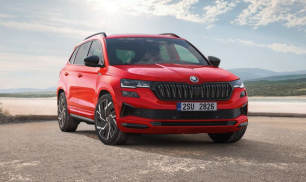VW has taken the opportunity with the ID.4 and its MEB platform to re-think cabin practicality. In the cockpit this means the standard raised console we usually see in a lot of mid-sizers has been replaced with a more modular floating console with some neat touches.
There's also a wide and spacious feel to the cabin thanks to the removal of structural elements usually reserved in combustion vehicles for things like the transmission or driveline tunnel.
The result is a big and airy cabin, reinforced by the big panoramic roof and more upright seating position.
Because there’s no centre console box, the front chairs also have drop-down armrests, which combine nicely with their generous side bolstering and padding to make for an armchair-like feel for front occupants. Lovely.
The touchscreen looks good and operates largely without any kind of lag, plus the layout is reasonable to work with. The main annoyance is using the convenient shortcut functions across the top of the screen for the settings menu or phone mirroring. These touch elements are quite small, forcing you to take your eyes off the road for a moment to interact with them. The same story goes for the touch-based sliders used for volume and climate controls. It’s simply never as good as physical buttons, and again, distracting to use on the move.
The console has impressive modularity. Up front there’s a tray which can either be fitted with removable dividers for a range of configurations, or you can slot a dual bottle-holder piece in there. This can be swapped into the lower section of the console, which also hides a cut-out for a wireless charger and two USB-C ports, and this lower area also has a sliding cover to keep everything tidy.
Meanwhile the back seat offers a spacious layout. At 182cm tall I have plenty of airspace for my knees behind my own driving position, and the width of the cabin is especially evident, with the centre seat position seemingly capable of accommodating a full-size adult if necessary.
They’ll also have somewhere to put their feet thanks to the flat floor, with the only limiting dimension being headroom. If you are taller than me you might be touching the roof, which dips down a little in the back to accommodate the rolling blind for the panoramic sunroof. At least it has one of these, unlike many other mid-size EVs.
The soft trims in the doors continue, but perhaps the best thing about the rear seats is the built-in strong contouring which gives the outboard positions a good level of comfort and genuine side bolstering.
While rear passengers benefit from a rare third climate zone, the adjustable vents and touch panel for this is located almost on the floor, making it hard to reach when you’re strapped in. It’s the same story for the dual USB-C charging ports.
For storage there’s large bottle holders in each door, three more in a drop-down armrest, as well as phone-sized pockets and bigger pockets on the backs of the front seats. Behind the drop-down armrest there’s a ski-port. Very Euro.
The boot measures 543 litres which seems about right for this segment. It comes with space under the floor for the storage of charging cables (of which, VW throws in both a wall socket version and a Type 2 to Type 2 cable for public charging) and an elastic net which is an underrated feature for stopping objects moving around while you’re driving. Like many other mid-size electric cars, there’s no spare wheel, just an inflator kit.
The ID.4 has no room left in its design for a frunk, which is an arguably gimmicky feature that many rivals have, although I must say there is the odd occasion where I have found them useful.

